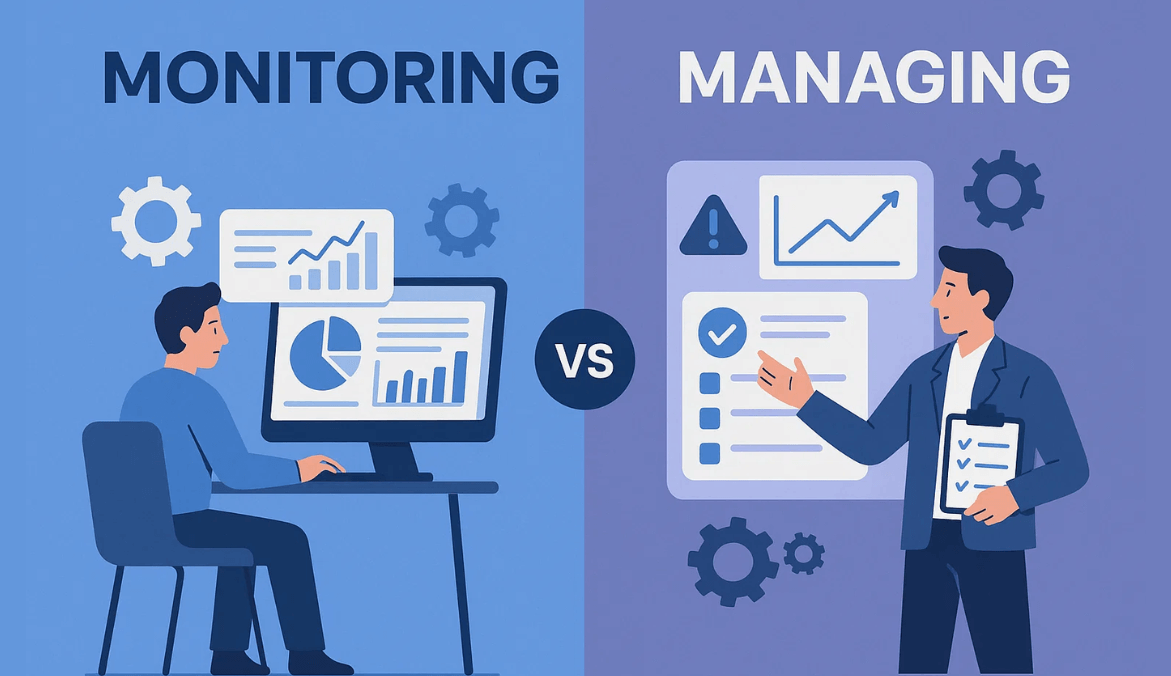Introduction
If you’ve ever rolled out a shiny new productivity tool expecting miracles — and ended up with more dashboards but fewer real improvements — you’re not alone.
Over my 15+ years working with teams across IT, operations, and service delivery, I’ve learned one truth that never changes:
“Tools don’t fix productivity — people do.”
Monitoring gives you visibility. Management gives you direction. Without both, you’re just staring at data hoping something will change.
According to Harvard Business Review, 60% of companies with remote workers now use employee monitoring software — and global demand for such tools has surged by 65% between 2019 and 2022.
That gap — between seeing performance and shaping it — is where most productivity initiatives fall apart.
In this article, I’ll break down what employee productivity management really means, how to bridge the “monitoring vs managing” divide, and how to use your tools in a way that drives measurable, human-centered improvement.
What Is Employee Productivity Management (and How It Differs from Just Monitoring)?
At its core, employee productivity management is about improving how people work — not simply how much they work. It’s the ongoing process of aligning time, effort, and focus with outcomes that matter to the business and to the individual.
Monitoring tells you what’s happening. Management ensures something better happens next.
A employee monitoring tool might show that an employee spent six hours in a CRM or two hours on email. But management asks: Did that time move the needle for our customers, team, or bottom line?
That’s the key distinction — monitoring gives you data, management gives you direction.
In my early consulting days, I once helped a team that was tracking 12 different productivity metrics per person. But not one of those metrics was tied to a business goal. When we simplified it to three clear outcome metrics — project delivery time, client satisfaction, and quality score — productivity went up, and stress went down.
The research backs this up. Atlassian Study found that teams connecting productivity metrics with business outcomes are 2.7x more likely to sustain improvement than those that just track activity.
The takeaway? Tracking activity is easy. Managing productivity is intentional — and that’s where leadership makes the difference.
The EMP Framework: From Monitoring to Management in 5 Steps
Over the years, I’ve developed a simple, repeatable model that helps teams move from observation to optimization. I call it the EMP Framework — Expose, Map, Prioritize, Manage, and Measure. Each step builds on the last and ensures monitoring leads to meaningful change.
1. Expose Work Patterns
Start by looking for patterns, not problems. Monitoring data is like an X-ray — it shows what’s happening under the surface. Use it to understand when focus peaks, how collaboration flows, and where time gets lost.
For instance, you might find your team’s productivity dips after 3 PM or that context-switching between tools costs 1.5 hours per day. That’s valuable insight — not blame.
Action tip: Don’t measure for control; measure for clarity. Frame data as discovery, not discipline. Encourage teams to share what surprises them — it builds trust and ownership.
2. Map Patterns to Goals
Once you’ve uncovered the patterns, map them to outcomes that matter. Ask: Do these behaviors align with our OKRs? Are we spending time on value-creating work?
This is where employee productivity management begins to shape direction. If your highest-performing sales reps spend 60% of their time in client calls, but others spend it in admin tasks, you’ve found a management opportunity — not a monitoring issue.
Action tip: Host quick “data reflection” sessions each week. Ask your team, “What does this tell us about how we work?” and “What can we adjust next week?” It keeps insights actionable and promotes shared accountability.
3. Prioritize Bottlenecks
Monitoring exposes friction points: approvals that stall, repetitive manual tasks, or uneven workloads. But management means turning those insights into action.
Create a simple workflow where bottlenecks are logged and addressed weekly. When your team sees that data leads to improvement — not punishment — their buy-in skyrockets.
Action tip: Each week, identify the top three blockers and assign one clear owner per issue. Even solving one bottleneck per week compounds into massive gains over a quarter.
4. Manage Through Rituals
Data is useless if it never sparks a conversation. Your rituals — team huddles, one-on-ones, retrospectives — are where management truly happens.
Replace data reviews that sound like audits with discussions that sound like alignment. Instead of “Why is your focus time low?”, ask “What’s getting in the way of deep work this week?”
In one enterprise rollout, simply shifting from daily activity reviews to weekly outcome discussions improved on-time delivery by 20%. Once people understood why the data mattered, engagement soared.
Gallup’s report reinforces this — employees who receive regular, constructive feedback are 3.6x more engaged than those who don’t.
Monitoring captures effort; management turns it into energy.
5. Measure and Evolve
The final step is to close the loop. Once you act on insights, measure the difference — are outcomes improving? Are focus hours up? Is output quality rising?
This stage prevents your monitoring data from going stale. As teams evolve, metrics should too.
Action tip: Create a KPI ladder — start with leading indicators (focus time, cycle time, active hours), then track lagging ones (delivery rate, cost per outcome, rework percentage). This builds a continuous feedback loop where management sharpens with every cycle.
Building a Privacy-First, Trust-Centric Approach
Many productivity initiatives fail not because of poor tools, but because of poor trust. When employees feel they’re being watched instead of supported, engagement plummets.
That’s why transparency must be at the heart of employee productivity management. Explain clearly what is being monitored, why, and how it benefits both the business and the employee.
Action tip: Share team-level trends, not individual reports, during reviews. This encourages collaboration instead of comparison — and promotes a healthier work culture.
I once saw a team’s morale drop overnight after management shared individual screenshots in a review meeting. It took months to rebuild confidence. Monitoring without empathy is micromanagement with data.
“A Gartner study found that only 10% of employees were once comfortable with being monitored — but that number rose to 30% just three years later. When organizations clearly explained the reasons behind monitoring, over 50% of employees said they were comfortable with it.
It’s proof that transparency transforms perception — when people understand the intent, monitoring feels less like surveillance and more like support.”
Tools Don’t Replace Managers — They Empower Them
Even the best productivity monitoring tools are only as effective as the managers using them. A tool can show trends, but only a manager can translate those insights into meaningful change.
Think of tools like Mera Monitor as visibility engines — they give you context, clarity, and evidence. But it’s the manager’s job to connect that visibility with purpose.
Action tip: Integrate your monitoring data into your management rhythm — weekly check-ins, OKR reviews, or Power BI dashboards. When data becomes part of your leadership habit, it stops feeling like surveillance and starts driving performance.
The role of management is evolving — from directing people to enabling them. Tools can track behavior, but only human leadership can inspire better outcomes.
Playbook: Turn Monitoring Into Managing
Here’s how to turn insights into impact over 90 days:
First 30 days: Observe without judgment. Gather baseline data — meetings, app usage, task completion rates, focus hours. Your goal is to understand patterns, not optimize them yet.
Next 30 days: Discuss findings openly. Ask the team what surprised them. Encourage suggestions for reducing friction or distractions. This builds ownership and shifts the mindset from being monitored to being empowered.
Final 30 days: Act on one or two priorities. Maybe it’s reducing meetings, rebalancing workloads, or automating recurring tasks. Then re-measure — see what actually improved.
Action tip: Celebrate early wins. Recognition is one of the strongest productivity drivers. When teams feel valued for progress, not perfection, they start self-managing more effectively.
Common Pitfalls (and How to Avoid Them)
Even with the right intentions, many organizations fall into predictable traps.
- Surveillance mindset: Productivity isn’t about “catching” people — it’s about coaching them.
- Data overload: Collecting too much data leads to paralysis, not progress.
- KPI theater: Metrics that don’t inform decisions are just noise.
Earlier in my career, I watched a project team collapse under the weight of 40 reports. Nobody knew what mattered. From then on, I made it a rule — if a metric doesn’t influence a decision, it doesn’t deserve your time.
Asana report supports this: employees waste 60% of their time on “work about work” — redundant meetings, duplicated efforts, and unclear priorities.
Conclusion: Productivity Grows Where Data Meets Direction
Employee productivity management isn’t a piece of software — it’s a leadership discipline. Monitoring gives you visibility. Management gives you movement. Culture gives you momentum. Together, they drive sustainable performance.
“Over the years, I’ve learned that productivity isn’t built on control — it’s built on clarity, communication, and compassion.”
The real transformation happens when leaders stop treating monitoring as observation and start using it as insight. If you’re ready to bridge that gap, explore how Mera Monitor helps teams turn data into direction — and visibility into real, measurable progress.
FAQs
It’s the practice of continuously improving how effectively employees work — combining monitoring data, management practices, and trust-driven culture.
Monitoring tracks actions; management turns those insights into strategy and support. One observes; the other enables.
Not sustainably. Tools reveal patterns, but improvement comes from how leaders interpret and act on those insights.
Yes, when done transparently and fairly. Employees should know what’s tracked, how it’s used, and how it benefits them.
Start by observing without judgment, then use those insights to create better workflows and communication. Measure, adjust, repeat.
 Gift Card ₹999
Gift Card ₹999

